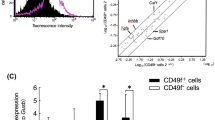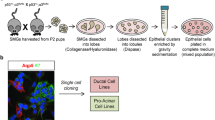Abstract
Rat submandibular glands can recover their function and secretory protein content following ductal ligation-induced atrophy. Morphological studies have established that following ligation, deligation of the gland allows the regeneration of new salivary gland tissue. However, little is known about changes happening during early regeneration following intra-oral duct ligation, which does not damage the parasympathetic nerves. Glands that had been 2 weeks ligated or 2 weeks ligated + 3 days deligated were compared. Tissue was prepared for histological, immunohistochemical (SMG-B and Ki-67) and immunocytochemical analyses (smooth muscle actin, aquaporin 5). Haematoxylin and eosin staining of deligated glands showed that some acini regained their cytoplasmic volume; moreover, the loss of Alcian blue/periodic acid-Schiff’s staining from the lumen of ducts suggested successful deligation. The deligated gland was characterized by atypical acinar-ductal branched structures, which were less frequent in the ligated gland and rarely seen in normal unoperated tissue. Myoepithelial cells were also investigated since changes in their morphology reflected changes in the acini morphology not readily detected by conventional staining. Actin staining revealed the presence of some shrunken acini in the atrophic tissue, whereas they had regained their normal morphology in the deligated gland suggesting that the acini were recovering. Some acini during deligation regained aquaporin 5 expression, which had decreased during atrophy. SMG-B protein, located in the pro-acinar cell during gland development and usually found in the intercalated duct cells in the adult, was detected in the newly formed acini of the deligated gland. This study suggests that morphological markers of regeneration appear as early as 3 days following ligation removal.








Similar content being viewed by others
References
Ball WD, Hand AR, Johnson AO (1988) Secretory proteins as markers for cellular phenotypes in rat salivary glands. Dev Biol 125:265–279
Ball WD, Hand AR, Moreira JE (1991) A neonatal secretory protein associated with secretion granule membranes in developing rat salivary glands. J Histochem Cytochem 39:1693–1706
Borghese E (1950) The development in vitro of the submandibular and sublingual glands of Mus musculus. J Anat 84:287–302
Burgess K, Dardick I, Cummins MM, Burford-Mason AP, Basset R, Brown DH (1986) Myoepithelial cells actively proliferate during atrophy of rat parotid gland. Radiol Endod 82:674–680
Carpenter G, Osailan SM, Correia PN, Paterson KL, Proctor GB (2007) Rat salivary gland ligation causes reversible secretory hypofunction. Acta Physiol 189:241–249
Cummins M, Dardick I, Brown D, Burford-Mason A (1994) Obstructive sialadenitis: a rat model. J Otolaryngol 23:50–56
Cutler LS, Chaudhry AP (1973) Intercellular contacts at the epithelial-mesenchymal interface during the prenatal development of the rat submandibular gland. Dev Biol 33:229–240
Cutler LS, Chaudhry AP (1974) Cytodifferentiation of the acinar cells of the rat submandibular gland. Dev Biol 41:31–41
Emmelin N, Garrett JR, Ohlin P (1974) Secretory activity and the myoepithelial cells salivary gland after duct ligation in cats. Arch Oral Biol 19:275–283
Garrett JR (1987) The proper role of nerves in salivary secretion: a review. J Dent Res 66:387–397
Harrison JD, Badir MS (1998) Chronic submandibular sialadenitis: ultrastructure and phosphatase histochemistry. Ultrastruct Pathol 22:431–437
Harrison JD, Garrett JR (1976) Histological effects of ductal ligation of salivary glands of the cat. J Pathol 118:245
Harrison JD, Fouad HM, Garrett JR (2001) Variation in the response to ductal obstruction of feline submandibular and sublingual salivary glands and the importance of the innervation. J Oral Pathol Med 30:29–34
Kishi T, Takao T, Fujita K, Taniguchi H (2006) Clonal proliferation of multipotent stem/progenitor cells in the neonatal and adult salivary glands. Biochem Biophys Res Commun 340:544–552
Ma T, Song Y, Gillespie A, Carlson EJ, Epstein CJ, Verkman AS (1999) Defective secretion of saliva in transgenic mice lacking aquaporin-5 water channels. J Biol Chem 274:20071–20074
Man YG, Ball WD, Culp DJ, Hand AR, Moreira JE (1995) Persistence of a perinatal cellular phenotype in submandibular glands of adult rat. J Histochem Cytochem 43:1203–1215
Man YG, Ball WD, Marchetti L, Hand AR (2001) Contributions of intercalated duct cells to the normal parenchyma of submandibular glands of adult rats. Anat Rec 263:202–214
Martinez JR (1987) Ion transport and water movement. J Dent Res 66:638–647
Martinez JR, Bylund DB, Cassity N (1982) Progressive secretory dysfunction in the rat submandibular gland after excretory duct ligation. Arch Oral Biol 27:443–450
Matsuzaki T, Suzuki T, Koyama H, Tanaka S, Takata K (1999) Aquaporin-5 (AQP5), a water channel protein, in the rat salivary and lacrimal glands: immunolocalization and effect of secretory stimulation. Cell Tissue Res 295:513–521
Matthews TW, Dardick I (1988) Morphological alterations of salivary gland parenchyma in chronic sialadenitis. J Otolaryngol 17:385–394
Moreira JE, Ball WD, Mirels L, Hand AR (1991) Accumulation and localization of two adult acinar cell secretory proteins during development of the rat submandibular gland. Am J Anat 191:167–184
Nagato T, Yoshida H, Yoshida A, Uehara Y (1980) A scanning electron microscope study of myoepithelial cells in exocrine glands. Cell Tissue Res 209:1–10
Norberg LE, Abok K, Lundquist PG (1988) Effects of ligation and irradiation on the submaxillary glands in rats. Acta Otolaryngol 105:181–192
Osailan SM, Proctor GB, Carpenter GH, Paterson KL, McGurk M (2006a) Recovery of rat submandibular salivary gland function following removal of obstruction: a sialometrical and sialochemical study. Int J Exp Pathol 87:411–423
Osailan SM, Proctor GB, McGurk M, Paterson KL (2006b) Intraoral duct ligation without inclusion of the parasympathetic nerve supply induces rat submandibular gland atrophy. Int J Exp Pathol 87:41–48
Patel VN, Rebustini IT, Hoffman MP (2006) Salivary gland branching morphogenesis. Differentiation 74:349–364
Redman RS (1994) Myoepithelium of salivary glands. Microsc Res Tech 27:25–45
Scott J, Liu P, Smith PM (1999) Morphological and functional characteristics of acinar atrophy and recovery in the duct-ligated parotid gland of the rat. J Dent Res 78:1711–1719
Shiba R, Hamada T, Kawakatsu K (1972) Histochemical and electron microscopical studies on the effect of duct ligation of rat salivary glands. Arch Oral Biol 17:299–309
Shwartz-Arad D, Michaeli Y, Zajicek G (1991) Compensatory hyperplasia of the rat submandibular gland following unilateral extirpation. J Dent Res 70:1328–1331
Takahashi S, Domon T, Yamamoto T, Wakita M (1997) Regeneration of myoepithelial cells in rat submandibular glands after yttrium aluminium garnett laser irradiation. Int J Exp Pathol 78:91–99
Takahashi S, Schoch E, Walker NI (1998) Origin of acinar cell regeneration after atrophy of the rat parotid induced by duct obstruction. Int J Exp Pathol 79:293–301
Takahashi S, Nakamura S, Suzuki R, Domon T, Yamamoto T, Wakita M (1999) Changing myoepithelial cell distribution during regeneration of rat parotid glands. Int J Exp Pathol 80:283–290
Takahashi S, Nakamura S, Shinzato K, Domon T, Yamamoto T, Wakita M (2001) Apoptosis and proliferation of myoeithelial cells in atrophic rat submandibular glands. J Histochem Cytochem 49:1557–1563
Takahashi S, Shinzato K, Domon T, Yamamoto T, Wakita M (2002) Proliferation and distrubution of myoepithelial cells during atrophy of the rat sublingual gland. J Oral Pathol Med 32:90–94
Takahashi S, Shinzato K, Domon T, Yamamoto T, Wakita M (2004a) Mitotic proliferation of myoepithelial cells during regeneration of atrophied rat submandibular glands after duct ligation. J Oral Pathol Med 33:430–434
Takahashi S, Shinzato K, Nakamura S, Domon T, Yamamoto T, Wakita M (2004b) Cell death and cell proliferation in the regeneration of atrophied rat submandibular glands after duct ligation. J Oral Pathol Med 33:23–29
Tamarin A (1971a) Submaxillary gland recovery from obstruction. I. Overall changes and electron microscopic alterations of granular duct cells. J Ultrastruct Res 34:276–287
Tamarin A (1971b) Submaxillary gland recovery from obstruction. II. Electron microscopic alterations of acinar cells. J Ultrastruct Res 34:288–302
Tamarin A (1979) The leukocytic response in ligated rat submandibular glands. J Oral Pathol 8:293–304
Tandler B (1993) Structure of the duct system in mammalian major salivary glands. Microsc Res Tech 26:57–74
Thaysen JH, Thorn NA, Schwartz IL (1954) Excretion of sodium, potassium, chloride and carbon dioxide in human parotid saliva. Am J Physiol 178:155–159
Walker NI, Gobe GC (1987) Cell death and cell proliferation during atrophy of the rat parotid gland induced by duct obstruction. J Pathol 153:333–344
Xu X, Diaz J, Zhao H, Muallem S (1996) Characterization, localization and axial distribution of Ca2+ signalling receptors in the rat submandibular salivary gland ducts. J Physiol (Lond) 491:647–662
Acknowledgements
The authors thank Dr. A. R. Hand (University of Connecticut, Farmington, USA) for providing us with the rabbit anti-ZZ3 polyclonal antibody.
Author information
Authors and Affiliations
Corresponding author
Additional information
The authors thank the Wellcome Trust for funding.
Rights and permissions
About this article
Cite this article
Cotroneo, E., Proctor, G.B., Paterson, K.L. et al. Early markers of regeneration following ductal ligation in rat submandibular gland. Cell Tissue Res 332, 227–235 (2008). https://doi.org/10.1007/s00441-008-0588-6
Received:
Accepted:
Published:
Issue Date:
DOI: https://doi.org/10.1007/s00441-008-0588-6




